Ijraset Journal For Research in Applied Science and Engineering Technology
- Home / Ijraset
- On This Page
- Abstract
- Introduction
- Conclusion
- References
- Copyright
A Study on Playful Work Design and Performance of Employees
Authors: M. Radhika, Shaik Fowziya Begum
DOI Link: https://doi.org/10.22214/ijraset.2024.63397
Certificate: View Certificate
Abstract
The work environment profoundly impacts employee satisfaction and productivity. A positive environment fosters teamwork, innovation, and unity through open communication, respect, and growth opportunities. Conversely, a negative environment leads to stress, low morale, and reduced performance. Organizations must prioritize creating supportive, inclusive workplaces that value well-being and promote work-life balance. Playful work design, integrating fun and creativity, enhances engagement and happiness, using gamification and flexible spaces. Gamification, with rewards and challenges, boosts motivation and performance by satisfying our drive for achievement. Managing work stress in leadership involves supporting managers with resources, promoting balance, and training in stress reduction and leadership skills. Cultivating open communication and mental health support is essential for effective stress management.\" This abstract encapsulates the main themes of the text, focusing on the importance of positive work environments, playful work design, gamification, and managing stress in leadership roles.
Introduction
I. INTRODUCTION
The work environment in an organization plays a crucial role in employee satisfaction and productivity."A positive work environment encourages teamwork, innovation, and a sense of unity among staff". It can be characterized by open communication, mutual respect, and growth opportunities. On the other hand, a negative work environment can lead to stress, low morale, and decreased performance. Organizations need to prioritize creating a supportive and inclusive work environment that values employee well-being and promotes a healthy work-life balance.
Playful work design is all about incorporating fun and creativity into the workplace. It's a way to boost engagement, productivity, and overall happiness at work. It can involve things like gamification, flexible workspaces, and incorporating elements of play into everyday tasks. It's a great way to make work more enjoyable and foster a positive work environment.
When it comes to engagement and performance, implementing gamification in the workplace can have a positive impact. By incorporating game-like elements, such as rewards, challenges, and leaderboards, employees become more motivated and invested in their work. This increased engagement often leads to improved performance and productivity. Gamification taps into our natural desire for achievement and recognition, making work more enjoyable and fulfilling.
Work stress in management can be a significant challenge. Managers often face high levels of responsibility, tight deadlines, and the need to make tough decisions. Overworking can cause stress and burnout. Organizations need to support their managers by providing resources for stress management, promoting work-life balance, and offering training on effective leadership and stress reduction techniques. Additionally, fostering a culture of open communication and support can help managers navigate work stress more effectively. Taking care of mental health is crucial for everyone, including managers.
II. REVIEW OF LITERATURE
ARTICLE 1- WORKPLACE ENVIRONMENT AND ITS IMPACT ON ORGANISATIONAL PERFORMANCE IN PUBLIC SECTOR ORGANISATIONS, Dr. K. CHANDRASEKAR
This study examines how employees can use playful work design to make work more fun and/or competitive by redesigning work activities. It employs proactivity and play theories to investigate this concept. We suggest that playful work design is positively related to job performance through work engagement
Dr. K. CHANDRASEKAR
This study uses proactivity and play theories to investigate playful work design – the personal initiative to change the psychological experience of work by redesigning work activities to be more fun and/or more competitive. We suggest that playful work design is positively related to job performance through work engagement
- Drawing on self-determination and play theories, we develop a process model that proposes that daily playful work design (PWD; designing fun, designing competition) positively relates to employees' daily work engagement through basic psychological need satisfaction.
- playful work design (PWD)—individuals’ personal initiative to change the psychological experience of work by redesigning work activities to be more fun or more competitive
- This article introduces the concept of playful work design—the process through which employees proactively create conditions within work activities that foster enjoyment and challenge without changing the design of the job itself. First, we review play theory and the motives people may have to play during work.
ARNOLD B. BAKKER
His study uses proactivity and play theories to investigate playful work design – the personal initiative to change the psychological experience of work by redesigning work activities to be more fun and/or more competitive.
Proactive workplace behavior is an active way of behaving at work that entails initiative to change the situation or oneself (Bakker, Citation2017; Bindl & Parker, Citation2020; Parker et al., Citation2010).
NARALIE KOEPPE
Despite the bourgeoning interest in talent management (TM) in the last two decades, limited research has been carried out to understand the diffusion of TM strategies and practices from home-country headquarters to their subsidiaries in host countries.
Proactive workplace behavior is an active way of behaving at work that entails initiative to change the situation or oneself (Bakker, Citation2017; Bindl & Parker, Citation2020; Parker et al., Citation2010).
AHMAD ARSLAN
Based on recent research on extreme work and social exchange theory, this paper presents a pioneering study focussed on public hospital nurses’ engagement in extreme work conditions and its associated ethical aspects.
We used qualitative data drawn from interviews conducted with nurses working in Egyptian hospitals. Due to the nature of this research, the participants in our study did not agree for their data to be shared publicly.
ZICHENG MA, HENG LIU
Despite recent progress, the literature is still unclear on the internal determinants of employee-related corporate social responsibility (CSR), particularly regarding the effect of the chief executive officer (CEO). Integrating upper echelons theory with the social class literature, this study examines how CEO social class perception influences private firms’ employee-related CSR. Based on a unique dataset from the Nationwide Private Firms Survey of China, this study empirically shows that higher CEO social class perception promotes a higher level of employee-related CSR activities in private firms.
Partial data that support the findings of this study are available from the corresponding author, Dr.Liu, upon reasonable request. And other data are not available due to ethical restrictions, which involve the legal rights and interests of third party.
III. OVERVIEW OF TOPIC
Playful work design refers to the intentional incorporation of elements that foster a sense of enjoyment, creativity, and engagement in the workplace. This approach is based on the understanding that when employees are motivated and inspired, they perform better and contribute more effectively to organizational goals. One key aspect of playful work design is autonomy, where employees are given the freedom to make decisions and manage their work in a way that suits their strengths and preferences. This autonomy not only promotes a sense of ownership and responsibility but also encourages innovation and initiative among employees.
Another important aspect is gamification, which involves applying game-like elements such as rewards, challenges, and competition to work processes. Gamification can make tasks more enjoyable and rewarding, leading to increased motivation and productivity. Moreover, it can foster a sense of camaraderie and teamwork as employees collaborate to achieve common goals and earn rewards.
Furthermore, playful work design emphasizes continuous learning and development opportunities for employees. This can include training programs, workshops, and mentorship initiatives that help employees enhance their skills and knowledge. When employees feel supported in their professional growth, they are more likely to be motivated and committed to their roles, leading to improved performance and job satisfaction.
Additionally, the physical workspace plays a crucial role in playful work design. A well-designed and stimulating workspace with vibrant colors, comfortable furniture, and interactive elements can boost creativity, collaboration, and overall well-being. Employees are more likely to feel inspired and energized in such an environment, leading to enhanced performance and creativity.
Moreover, feedback and recognition are integral components of playful work design. Regular feedback, constructive criticism, and acknowledgment of achievements help employees understand their strengths and areas for improvement. This fosters a culture of continuous improvement and encourages employees to strive for excellence in their work.
Furthermore, work-life balance initiatives are essential in playful work design. Organizations that support employees in managing their personal and professional lives create a healthier and more engaged workforce. Employees who feel valued and supported in achieving work-life balance are more likely to be motivated, focused, and productive.
IV. OBJECTIVES OF PLAYFUL WORK DESIGN AND PERFORMANCE OF EMPLOYEES
- Engagement and Motivation: The objective is to create a work environment that captures employees' interest and enthusiasm, motivating them to actively participate in tasks and projects.
- Creativity and Innovation: By infusing playfulness, the goal is to stimulate employees' creativity, encouraging them to think creatively, generate new ideas, and find innovative solutions to challenges.
- Communication and Collaboration: The aim is to promote effective communication and foster collaboration among team members, leading to improved teamwork, sharing of ideas, and collective problem-solving.
- Skill Development and Learning: The objective is to use playful elements to facilitate learning and skill development, making training programs engaging, interactive, and conducive to knowledge retention.
- Well-being and Job Satisfaction: The goal is to create a positive work culture that prioritizes employee well-being, reduces stress, and enhances job satisfaction, resulting in higher levels of productivity and overall happiness at work.
- Adaptability and Resilience: Playful work design aims to cultivate a mindset of adaptability and resilience, encouraging employees to embrace change, learn from failures, and thrive in dynamic work environments
V. SCOPE OF PLAYFUL WORK DESIGN AND PERFORMANCE OF EMPLOYEES
Playful work design has emerged as a crucial aspect of enhancing employee performance and overall organizational effectiveness. By infusing elements of playfulness into the work environment, organizations can create a conducive atmosphere that fosters creativity, innovation, and employee engagement. This approach involves incorporating games, challenges, and interactive activities into everyday tasks, thereby making work more enjoyable and stimulating for employees.
One significant scope of playful work design is its positive impact on employee motivation. When employees are encouraged to participate in playful activities such as team-based games or creative problem-solving tasks, they experience a sense of accomplishment and satisfaction. This, in turn, boosts their motivation levels and encourages them to perform at their best. Additionally, playful work design promotes a culture of collaboration and camaraderie among team members, leading to improved teamwork and synergy within the organization.
VI. IMPROTANCE OF PLAYFUL WORK DESIGN AND PERFORMANCE OF EMPLOYEES
Playful work design plays a crucial role in enhancing the performance of employees in various ways. Firstly, it fosters a positive and enjoyable work environment, which is essential for employee engagement and motivation. When employees find their work environment enjoyable and stimulating, they are more likely to be motivated to perform at their best and remain committed to their tasks.
Secondly, playful work design promotes creativity and innovation among employees. By incorporating elements of playfulness into everyday tasks, such as gamified challenges or creative brainstorming sessions, employees are encouraged to think outside the box and come up with innovative solutions to problems. This not only benefits the organization by driving innovation but also empowers employees to unleash their full potential and contribute creatively to the workplace.
Furthermore, playful work design contributes to improved communication and collaboration within teams. Activities like team-building games, collaborative projects, or interactive workshops create opportunities for employees to interact, communicate effectively, and build stronger relationships. This, in turn, leads to better teamwork, coordination, and synergy among team members, ultimately enhancing overall performance.
VII. ADVANTAGES OF PLAYFUL WORK DESIGN AND PERFORMANCE OF EMPLOYEES
Playful work design offers several advantages that directly contribute to enhancing the performance of employees and promoting overall organizational success. One of the key advantages is the boost in employee motivation and engagement. When employees are provided with a work environment that incorporates playful elements such as gamified tasks, interactive challenges, and creative activities, they are more likely to feel motivated and enthusiastic about their work. This increased motivation leads to higher levels of engagement, improved focus, and a greater sense of fulfillment in their roles.
Furthermore, playful work design fosters a culture of creativity and innovation within the organization. By encouraging employees to think outside the box, explore new ideas, and experiment with different approaches, playful work environments can result in innovative solutions to problems, product improvements, and process optimizations. This creative mindset not only benefits individual employees but also contributes to the overall growth and competitiveness of the organization in the market.
Another advantage of playful work design is its positive impact on collaboration and teamwork. Playful activities such as team-building games, collaborative projects, and brainstorming sessions help strengthen relationships among team members, improve communication channels, and foster a sense of camaraderie. This collaborative environment leads to better coordination, faster decision-making, and more effective problem-solving, ultimately enhancing team performance and productivity.
Moreover, playful work design contributes to the continuous development of employees' skills and knowledge. Gamified learning experiences, training programs with interactive elements, and skill-building activities make learning more engaging, enjoyable, and effective. Employees are more likely to retain information, apply new skills in their roles, and stay motivated to pursue continuous learning and development opportunities.
Additionally, playful work design promotes employee well-being and job satisfaction. When employees have the opportunity to engage in fun and enjoyable activities at work, they experience lower levels of stress, higher levels of job satisfaction, and an improved work-life balance. This positive work environment leads to higher employee retention rates, reduced absenteeism, and a more positive organizational culture overall.
Increased Employee Engagement: Playful work design encourages active participation and engagement among employees, leading to higher levels of interest and enthusiasm in their tasks and projects.
VIII. LIMITATIONS OF PLAYFUL WORK DESIGN AND PERFORMANCE OF EMPLOYEES
The study has some limitations that need to be addressed. Firstly, self-report measures may have potential concerns regarding the accuracy of the observed associations. Future studies should use multiple sources to measure performance. Secondly, more research methods like quasi-experiments and diary studies may provide stronger evidence for causality. Lastly, the sample consisted of working students who might have scored high on conscientiousness. However, we still found the predicted relationships, and the use of conscientiousness as a moderator should be considered a conservative test.
IX. RESEARCH METHODOLOGY
Crafting a research methodology for investigating the impact of playful work design on employee performance involves meticulous consideration of several elements. Here's a revised and rearranged version of the proposed methodology:
A. Research Objective
Begin by clearly defining the study's objective, aiming to elucidate the correlation between playful work design and employee performance while identifying the constituents of a playful work milieu.
B. Literature Review
Commence with an extensive review of existing literature encompassing playful work design, employee engagement, organizational psychology, and performance evaluation. This endeavor will furnish a theoretical scaffold and pinpoint gaps in current research.
C. Research Design
- Sampling Strategy
Define the target population, possibly employees within specific departments or organizations.
Implement random sampling techniques to ensure a representative sample.
Take into account variables like organizational size, industry, and demographics while selecting participants.
D. Data Collection
Devise survey instruments or interview protocols based on the research objectives and literature review.
Administer surveys or conduct interviews to gather data on various aspects, including perceptions of playful work design, organizational culture, job satisfaction, creativity, collaboration, and performance metrics.
Ensure the integrity, reliability, and ethical adherence of data collection methods.
E. Data Analysis
Utilize statistical analysis techniques to dissect quantitative data, such as correlation analysis, regression analysis, or structural equation modeling, elucidating the nexus between playful work design and employee performance.
Employ thematic analysis or content analysis to scrutinize qualitative data, unveiling patterns or themes associated with playful work design and its influence on employee behavior and performance.
F. Integration of Findings
Merge insights gleaned from both quantitative and qualitative analyses to furnish a holistic comprehension of the interplay between playful work design and employee performance.
Interpret the findings vis-à-vis the research objectives and theoretical framework delineated in the literature review.
G. Discussion and Conclusion
Engage in an in-depth discourse on the implications of the findings for both theory and practical application, accentuating key discoveries and offering pragmatic recommendations for organizational enhancement.
Sum up the study's contributions to the field and delineate potential avenues for future research endeavors.
H. Ethical Considerations
Adhere rigorously to ethical principles throughout the research journey, ensuring compliance with informed consent protocols, confidentiality maintenance, and ethical guidelines governing studies involving human subjects.
I. Limitations
Acknowledge any inherent limitations of the study, such as sample size constraints, potential biases, or generalizability issues, and elucidate their probable impacts on the findings' validity and reliability.
By adhering to this meticulously crafted research methodology, scholars can methodically explore the relationship between playful work design and employee performance, thereby enriching the realms of organizational psychology and management with invaluable insights.
J. Research Design
Research Type: Descriptive in nature
Research Design: Qualitative
Data collection: Data is collected in two ways.
Primary Data: through questionnaire
Secondary data: through journals, articles, and books
Data Collection tool: questionnaire
Population: 100
Sample frame: Medchal Division
Sample unit: Medchal Region
Sample size: 63
Sampling Technique: random sampling
Analysis tools used: pie chart, bar graph, percentages
K. Objectives
1. Enhancing employee engagement and satisfaction through the implementation of playful work design strategies.
2. Investigating the impact of playful work design on employee creativity and innovation.
L. Hypothesis
- Hypothesis 1
Null Hypothesis (H0): Workplace performance does not significantly differ between environments with playful work design and those without.
Alternative Hypothesis (H1): There exists a significant discrepancy in workplace performance between environments with playful work design and those lacking such elements, indicating superior performance in workplaces with playful design features.
2. Hypothesis 2
Null Hypothesis (H0): No significant correlation exists between employees' perception of a playful work environment and their job satisfaction.
Alternative Hypothesis (H1): A significant positive correlation is present between employees' perception of a playful work environment and their job satisfaction, suggesting that higher perceptions of workplace playfulness correspond to increased job satisfaction among employees. Certainly! Here are the rewritten hypotheses:
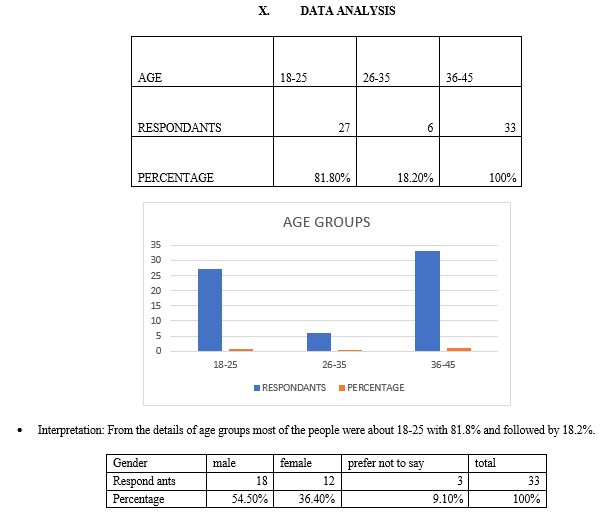

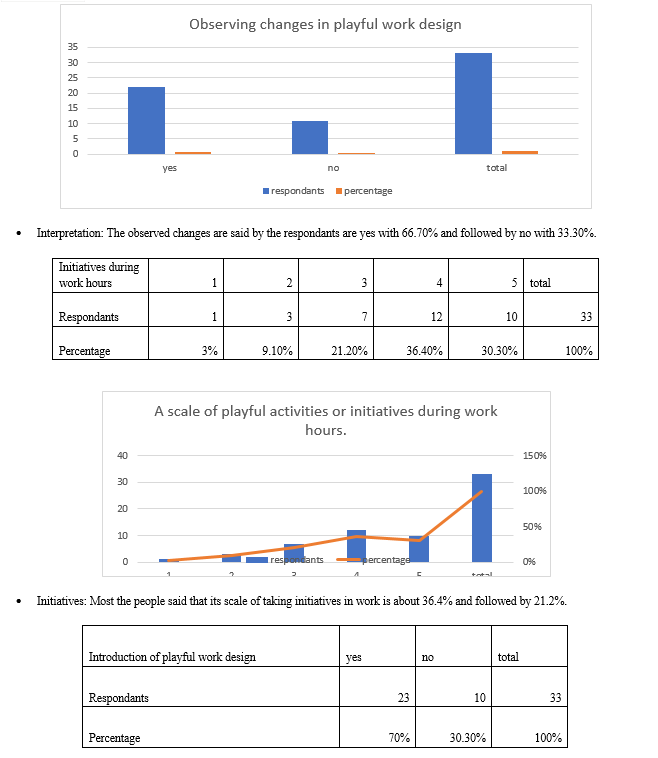
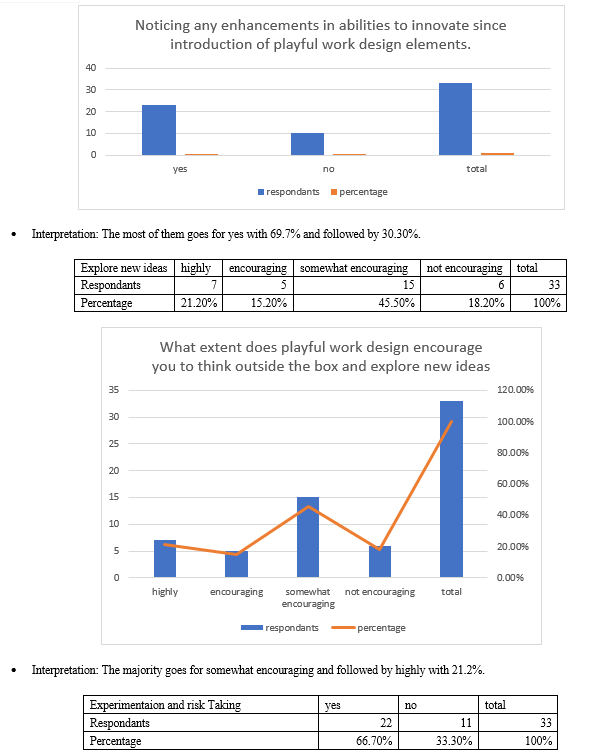
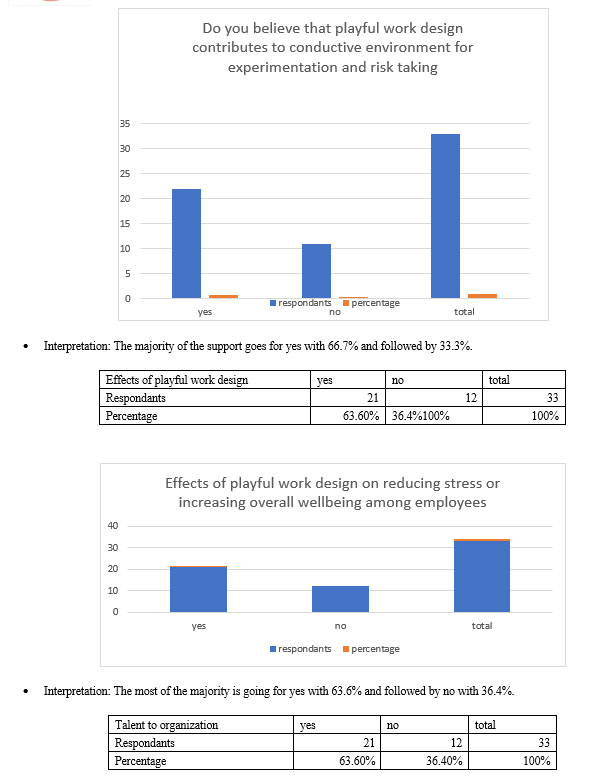
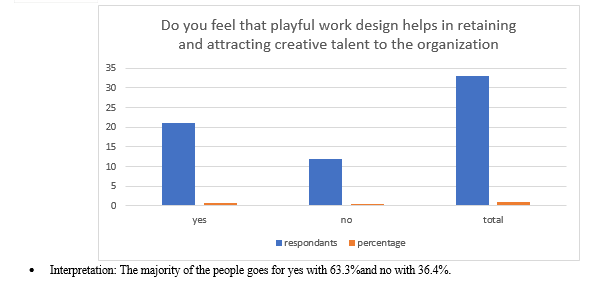
XI. FINDINGS
From the details of age groups most of the people were about 18-25 with 81.8% and followed by 18.2%.
The most the people are male with 54.50% and followed by 36.40% by female
The level of work engagement at work is rated through at max 4th level with 42.4%and followed by 5th level with 33.3%.
The observed changes are said by the respondants are yes with 66.70% and followed by no with 33.30%.
Most the people said that its scale of taking initiatives in work is about 36.4% and followed by 21.2%.
The most of them goes for yes with 69.7% and followed by 30.30%.
The majority goes for somewhat encouraging and followed by highly with 21.2%.The majority of the support goes for yes with 66.7% and followed by 33.3%.
The most of the majority is going for yes with 63.6% and followed by no with 36.4%.
The majority of the people goes for yes with 63.3%and no with 36.4%.
XII. SUGGESTIONS
Conduct a comprehensive literature review to identify gaps in existing research on playful work design, employee motivation, engagement, and performance.
Choose appropriate research methods, such as qualitative interviews and quantitative surveys, to gather comprehensive data on employee experiences and performance.
Select a diverse sample of organizations and employees across different industries and job roles to ensure broad representation.
Develop survey questionnaires or interview guides tailored to research objectives and collect data on employees' experiences with playful work design elements.
Define clear objectives to measure employee performance within the context of playful work design.
Analyze collected data using statistical techniques or qualitative methods to examine the relationship between playful work design factors and performance outcomes.
Interpret findings in the context of research objectives and discuss how playful work design influences employee performance.
Discuss practical implications of findings for organizations and provide actionable recommendations for implementing playful work design initiatives.
Identify areas for future research to further explore the complexities of playful work design and its impact on employee performance in different organizational contexts.
Conclusion
This study delves into the intricate correlation between playful work design and employee performance. Through conducting a thorough literature review and employing appropriate research methodologies, our aim was to comprehend how integrating elements of enjoyment and creativity in the workplace impacts employee motivation, engagement, and overall performance. Our analysis of gathered data and interpretation of results have yielded valuable insights into the positive influence of playful work design on employee performance outcomes. We emphasize the importance of fostering an environment that promotes enjoyment, autonomy, and continuous learning, as these factors significantly contribute to heightened productivity and job satisfaction among employees. The practical implications of our findings indicate that organizations stand to gain from implementing playful work design initiatives to nurture a positive and supportive work culture. By offering opportunities for creativity, collaboration, and personal growth, organizations can elevate employee morale, alleviate stress, and ultimately enhance performance outcomes. Moreover, our study underscores the ongoing need for research in this area to delve deeper into the complexities of playful work design and its impact on employee performance in various organizational settings. Continued investigation will provide deeper insights into the underlying mechanisms linking workplace design to employee outcomes, thus enabling the development of more effective strategies to improve organizational performance and employee well-being.
References
[1] Dr. K. Chandrasekar, A study on workplace environment and its impact on organisational performance in public sector organisations. [2] Arnold B. Bakker, A study on playful work design, engagement and performance: the moderating roles of boredom and conscientiousness. [3] Natalie koeppe, A study on talent management in german multinational firms in china: the role of headquarters-subsidiary relations. [4] Ahmad Arslan, A study on live like an ant to eat sugar: nurses’s engagement in extreme work conditions and their perceptions of its ethicality. [5] Zicheng Ma, Heng Liu, A study on how does CEO social class perception impact employee-related CSR. Evidence from privately owned Chinese firms. [1] Abramis, D. J. (1990). Play in work: Childish hedonism or adult enthusiasm? American Behavioral Scientist, 33(3), 353–373. https://doi.org/10.1177/0002764290033003010 [2] Christian, M. S., Garza, A. S., & Slaughter, J. E. (2011). Work engagement: A quantitative review and test of its relations with task and contextual performance. Personnel Psychology, 64(1), 89–136. https://doi.org/10.1111/j.1744-6570.2010.01203.x [3] Costa, P. T., Jr, McCrae, R. R., & Dye, D. A. (1991). Facet scales for agreeableness and conscientiousness: A revision of the NEO Personality Inventory. Personality and Individual Differences, 12(9), 887–898. https://doi.org/10.1016/0191-8869(91)90177-D
Copyright
Copyright © 2024 M. Radhika, Shaik Fowziya Begum. This is an open access article distributed under the Creative Commons Attribution License, which permits unrestricted use, distribution, and reproduction in any medium, provided the original work is properly cited.

Download Paper
Paper Id : IJRASET63397
Publish Date : 2024-06-21
ISSN : 2321-9653
Publisher Name : IJRASET
DOI Link : Click Here
 Submit Paper Online
Submit Paper Online

